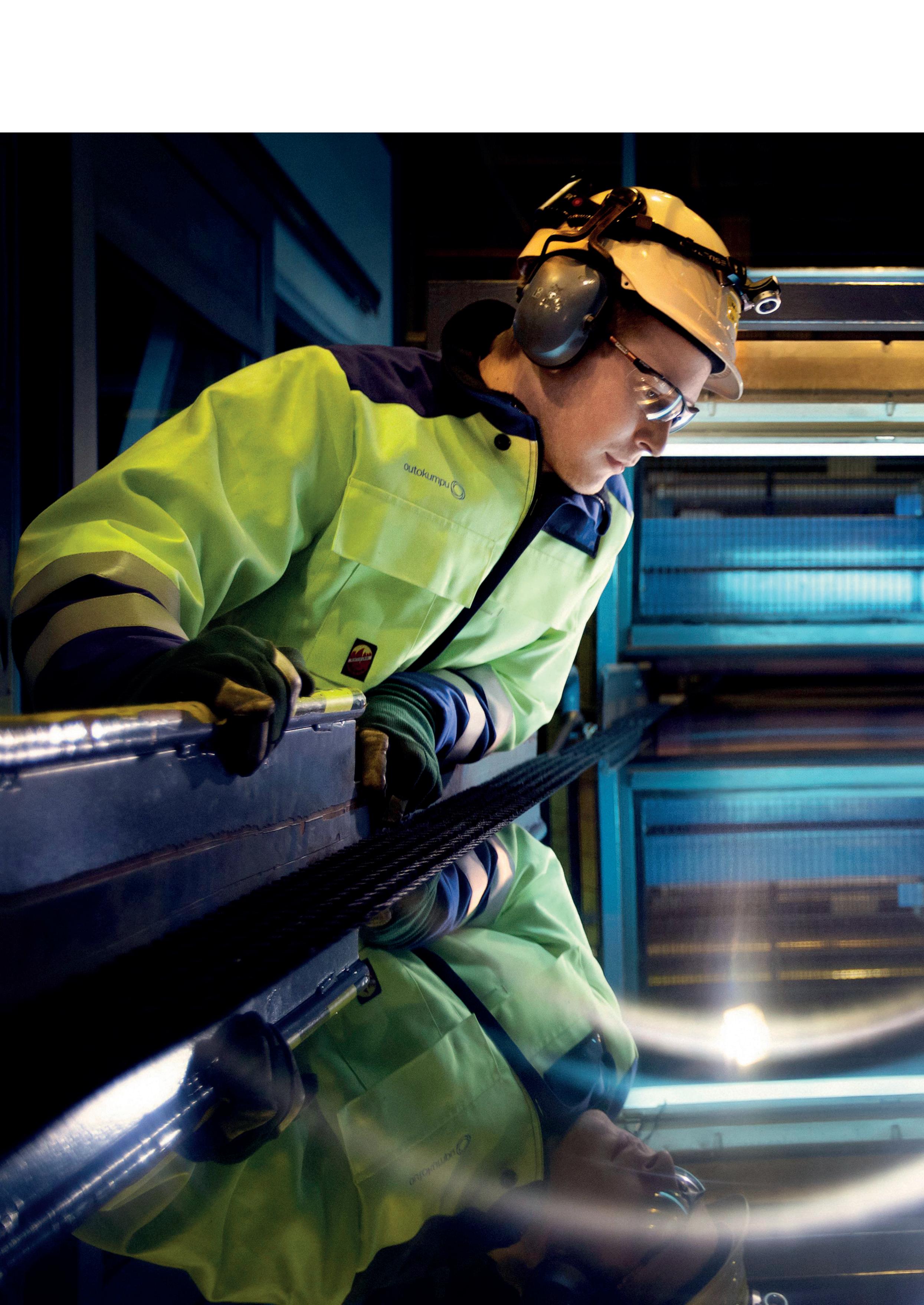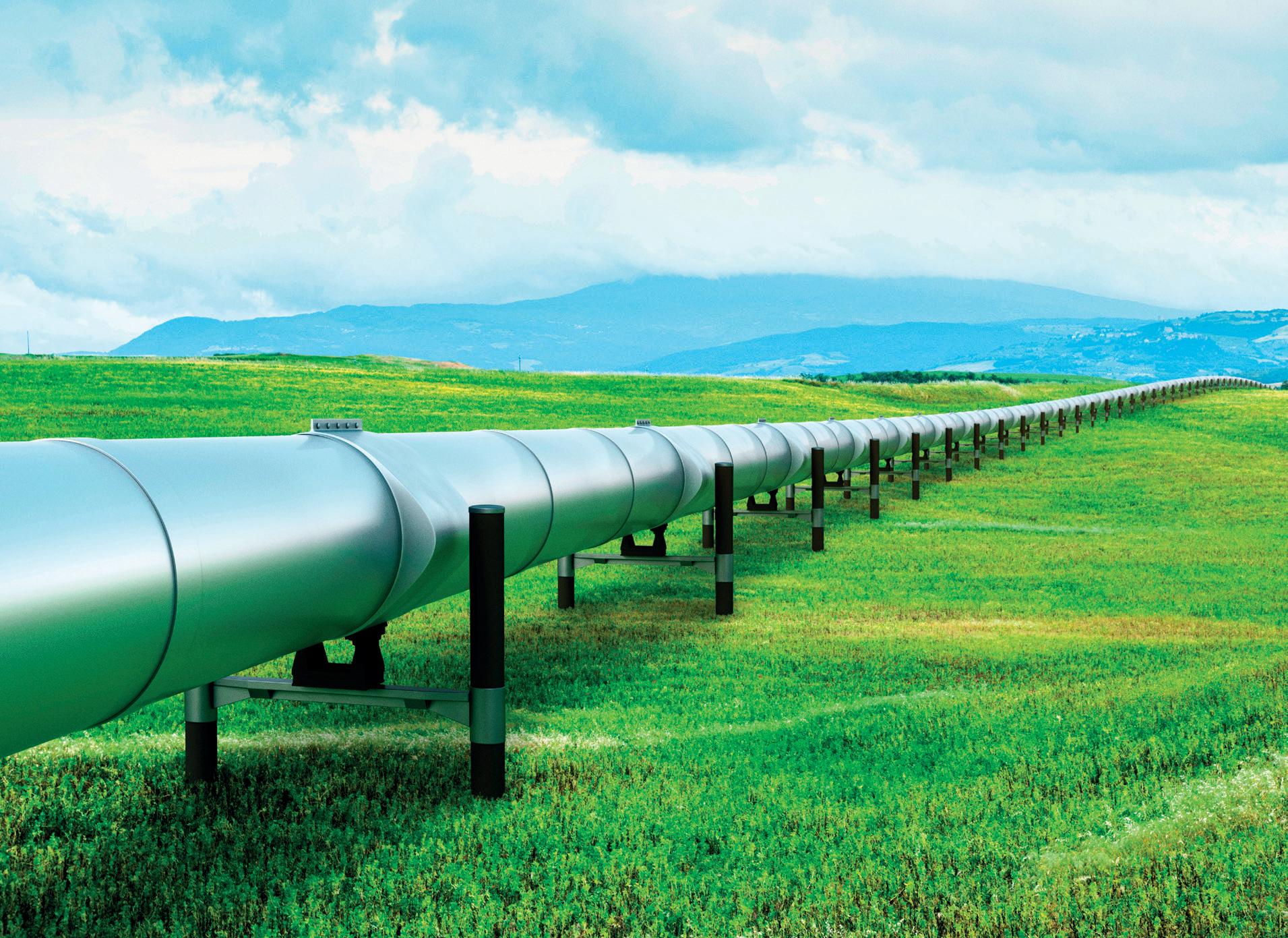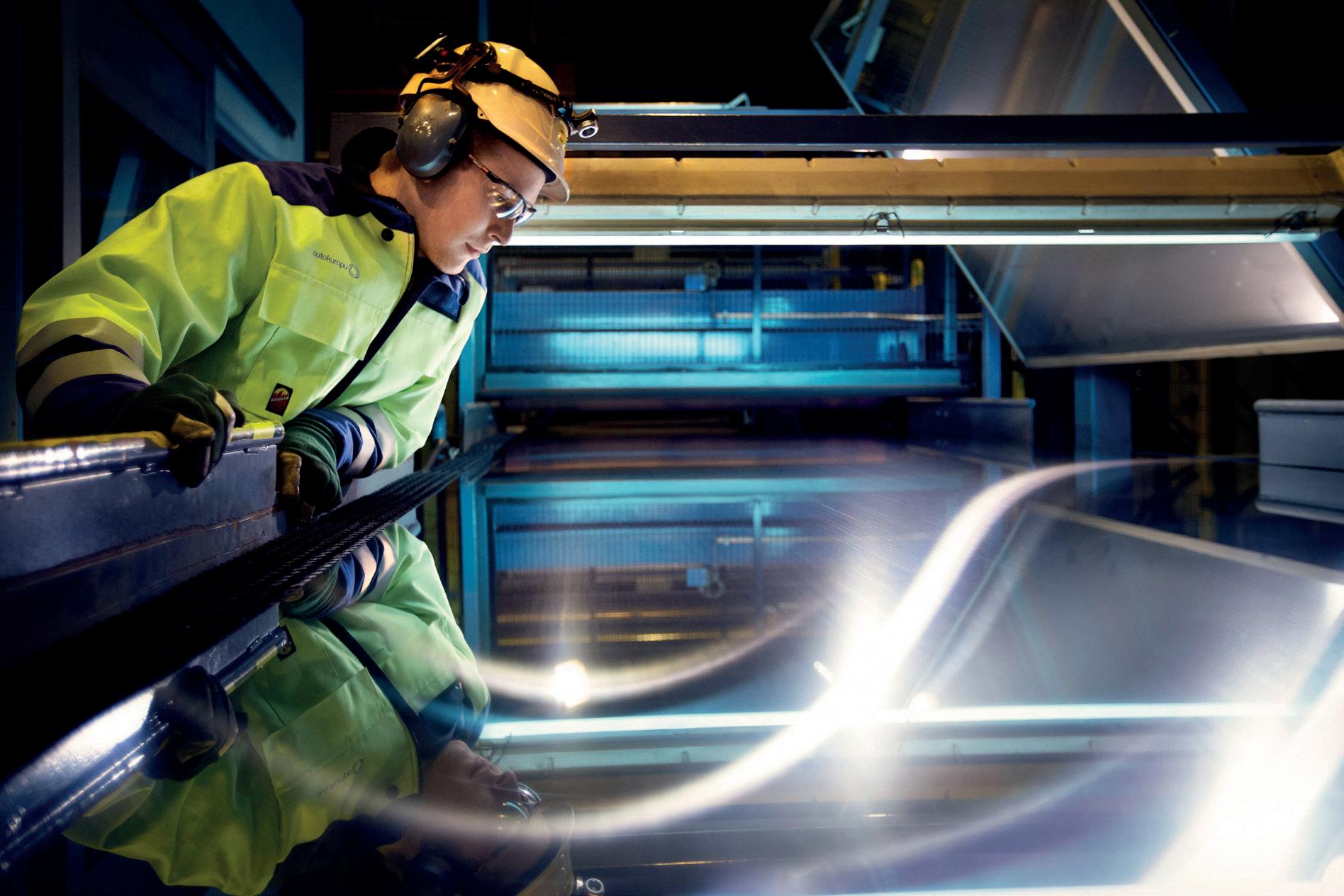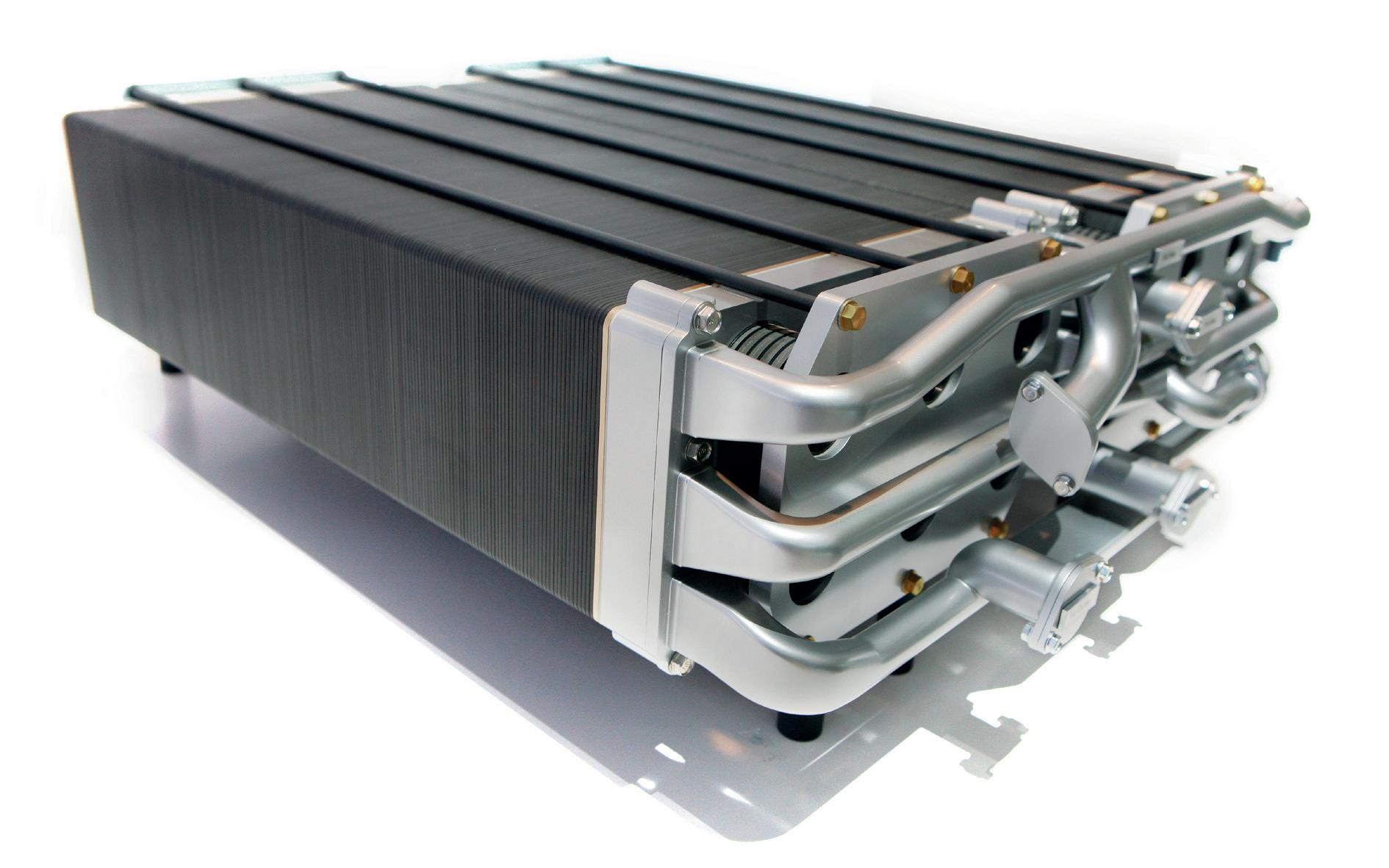
10 minute read
Stainless steel storage
The growing hydrogen industry will require high-performance materials in many applications – from gas storage and water management, to electrolysis and carbon capture. Marie Louise Falkland, Outokumpu, Sweden, discusses how stainless steel fits the bill for different applications.

Hydrogen holds a lot of promise as a low-carbon source and carrier of energy for transport and heavy industry. Ensuring its safe and effective production and storage will require stainless steel at many stages along the hydrogen value chain: for hydrogen storage tanks, in fuel cells and electrolysers, as tanks onboard ferries or at fuelling stations, and for hydrogen pipelines.
Cryogenic performance
One of the most important applications is storage and transportation. This will require tanks that are practical, safe and reliable. Stainless steel is ideal for this as it has the beneficial combination of ductility at extremely low temperatures, and the ability to withstand hydrogen embrittlement.
The challenge with storing and transporting hydrogen as a liquid is that its boiling point at atmospheric pressure is -253°C, so operators will need materials that can cope. Cryogenic operation requires ductility at low temperatures to avoid brittle fractures that could impact the structural integrity of a storage vessel.
Multiple grades of stainless steel are already well proven for this type of environment, and are listed in technical standards such as the ASME Boiler and Pressure Vessel Code, and EN 13445-2. What these have in common is that they have an austenitic microstructure that enables them to operate at temperatures of as low as -273°C.

Figure 1. The growing hydrogen industry will require high-performance materials in many applications, such as pipelines.
Figure 2. Many grades in the stainless steel family offer the ideal combination of strength and corrosion resistance for the wide range of applications in hydrogen production, storage and consumption.
Figure 3. Stainless steel is important for fuel cells as the material for stacking plates that guide the flow of air and fuel.


Resisting hydrogen embrittlement
The other big issue is the potential for hydrogen embrittlement of steels and metals in general. Sensitivity to hydrogen embrittlement varies, depending on the material. High-strength steel, titanium and aluminium alloys are all vulnerable to hydrogen embrittlement. Sensitivity also varies between different types of stainless steel.
Austenitic stainless steels have higher resistance to hydrogen embrittlement than ferritic and martensitic alloys, as hydrogen’s rate of diffusion through the material is low. Therefore, along with the low-temperature ductility, this makes austenitic stainless steel a good option for hydrogen storage.
The risk of hydrogen embrittlement increases with the pressure. There is little risk of hydrogen embrittlement at low pressures. As such, most stainless steels are suitable for storing or transporting hydrogen when pressure is not excessive.
However, as the pressure rises, so does the force that pushes atoms into the internal surface of a tank. As a result, it becomes more likely that hydrogen atoms will diffuse into the steel matrix of tank walls or the body of pipework. As austenitic stainless steel has a lower diffusivity of hydrogen than other stainless steel types, it is the preferred material – especially in many storage applications that operate in the range of 200 bar, with some sites working at up to 800 bar.
Alloying elements in the stainless steel also play a role in reducing susceptibility to hydrogen embrittlement. The industry has a rule of thumb that the most suitable materials are low-carbon austenitic stainless steels with around 12 – 13% nickel, and 2 – 3% molybdenum. This combination of nickel and molybdenum has been found to resist the diffusion of hydrogen, making it particularly attractive for hydrogen storage and transport tanks as the industry develops.
This is a current area of research for Outokumpu’s metallurgists who are working on a long-term project that has the goal to fully understand how the alloying elements influence how hydrogen diffuses into the material, and eventually find the optimum alloy to avoid hydrogen embrittlement.
Storage and transport tanks
The storage of compressed hydrogen will require robust tanks. The basic construction of these will be based on a tank or cylinder with an inner and outer shell, with the inner shell containing the hydrogen and the outer having the purpose of resisting the internal pressure.
Four design options are available: y Type I with walls made from metal alloys that have the capability to contain up to 200 bar. y Type II tanks with a metal inner skin and an outer that is cylindrically covered with resin-soaked glass or carbon fibres to provide capability of withstanding up to 1000 bar. y Type III uses a metal liner fully covered by a carbon fibre outer, which has the capability of withstanding up to 350 or 700 bar, which is the standard for vehicles.
y Type IV features walls constructed from composites, e.g. a carbon-reinforced tank with a polymer liner.
The metal inner tank material varies between steel, aluminium and stainless steel. Meanwhile, tanks for liquid hydrogen storage will call for materials that can withstand cryogenic conditions. Tanks will have inner and outer shells, with a vacuum or a layer of insulation between them. In terms of construction, the inner tanks will need to be able to manage the low temperatures, whereas the outer shells need to resist the outer environment.
A further option for storage is underground tanks. In these tanks, the walls will be built from a gas-tight material such as stainless steel, and the mechanical support will come from the rock walls of the underground chamber. This might be a pit made solely for this purpose, or an old mine.
Hydrogen production and use
Green hydrogen is usually produced by an electrolyser – in which electricity is used to split clean water into hydrogen and oxygen – whereas in the fuel cell, the hydrogen is converted to energy and water.
Multiple technologies are available and under development for electrolysers and fuel cells, all with different requirements for the materials being used. The material requirements are similar for a technology no matter whether it is used in an electrolyser or in a fuel cell. Material selection is determined by the type of technology, i.e. in terms of electrolyte, operating temperature, fabrication demand and physical properties, and further by the type of usage, e.g. the mobility if it is stationary use or a mobile application.
Fuel cells and electrolysers
Typically, the fuel cell technologies that operate at higher temperatures of 200 – 1000 °C, such as solid oxide fuel cells (SOFC), molten carbonate fuel cells (MCFC), and phosphoric acid fuel cells (PAFC), have a long lifetime. However, they have a long start-up time to reach the required operating temperature, making them less suitable for many vehicle applications where intermittent operation is required.
Conversely, alkaline fuel cells (AFCs) and polymer electrolyte fuel cells (PEFCs) operate at around 100°C and 80°C, respectively. Compared with high-temperature fuel cells, they have a higher power density and have more flexible operation. The fact that they require less protective packaging and insulation makes them more compact and lightweight for mobile applications such as trucks.
Stainless steel as the material for stacking plates that guide the flow of air and fuel over each side of the electrolyte is important for fuel cells. It is used as the material to make three types of plate component. The first is the thicker end plates that hold the stack together.
GLOBAL ELECTROLYZER MARKET ASSESSMENT
Competitive Benchmarking & Dynamic Market Forecasting
Data-Driven Market Research
> 130 Companies
> 30 Gigafactories
Up-To-Date Power Ranking

The Global Electrolyzer Market Guide provides a one-stop resource for anyone looking to better understand the market. The guide includes more than 130 electrolyzer technology companies, covering start-ups, innovators and key industry players across the globe. Get the most comprehensive competitive assessment of technology owners.

Figure 4. Stainless steel is ideal for applications across the hydrogen production chain, such as the ball valves shown here.
Figure 5. Stainless steel is produced under tightly-controlled conditions to ensure high quality and performance.

Secondly, the thinner interconnecting plates provide strength and apertures for fuel and air to flow into the stack, and for water to escape. The third and final stainless steel plate in a fuel cell stack is the cathode contact, which has flow channels machined into its surface to guide air and fuel across the electrolyte.
High-temperature technologies
Looking at the high-temperature end of the market, stainless steel has the right properties for SOFC technology, which operates in the region of 600 – 1000 °C, as it provides good strength and corrosion resistance in this range. In addition to this, it has a low thermal expansion coefficient and is electrically-conductive, and therefore performs both mechanical and electrical roles.
In 2020, around 150 MW of fuel cell capacity was deployed around the world and most of this was based on very high temperature technology that works at 850°C and above. It requires highly-specialist ferritic stainless steels that are complex to manufacture. These are typically produced in low volumes by specialist mills, and are therefore costly.
Meanwhile, steels based on grade EN 1.4509 (441) and 1.4622 are suitable for fuel cells that work in the range of 600 – 750°C. These make use of recently-developed ceramics that are able to work at the required temperatures. Because the temperature is significantly lower, fuel cells in this range are the less severe environments for all the materials, meaning that it is possible to save costs by using alloys that are more widely produced.
Low-temperature technologies
Similar properties are required for polymer electrolyte membrane (PEM) fuel cells and electrolysers that operate at up to 100°C, although thermal expansion is less of a concern. For example, a PEFC might have 200 – 400 plates in a stack, and so the plates must be amenable to straightforward manufacture and assembly.
This type of fuel cell for mobile use needs to have the flexibility to cope with fast load changes, as a vehicle moves in traffic. In addition to this, it needs to be suitable for cold start, and provide high power density in a compact package to fit inside vehicles. Stainless steel grade such as 316L is suitable for this. It is impermeable to gas, provides both thermal and electrical conductivity, and resists corrosion. In addition, it has the required level of formability for the shaping of channels, and has the strength to provide structural integrity in a lightweight sheet even thinner than 0.1 mm, which is used in mobile PEFC.
For stationary electrolysers using the PEM technology, weight is of less importance, and usually the plates are thicker than in the mobile versions. Stainless steel is used as an alternative to titanium for this type of application, and is significantly less costly. This makes it particularly attractive for mass production.
Tubes, fittings, compressors, heat exchangers, etc are used to connect equipment and adjust the temperature and pressure of hydrogen. For many of these applications, 316L type of stainless steel shows excellent performance when coping with the low temperatures and the hydrogen diffusion.
Meanwhile, to ensure a long life for the catalyst in the electrolysis of green hydrogen, producers need to treat water into its purest form before they can use it as feedstock. The corrosion resistance of stainless steel in water filters, reverse osmosis plants, distillation and water storage tanks will protect water quality.
Similarly, when producing hydrogen from methane, oil or coal as a feedstock, producers will need to adopt carbon capture and utilisation (CCU) or carbon capture and storage (CCS). Stainless steel is also useful in the processing equipment used for this.
Conclusion: choose the right grade
There are also many applications in hydrogen use that can benefit from stainless steel’s corrosion resistance, gas impermeability and strength, i.e. as a structural material in fuel cells for heating systems, as well as for tanks on vehicles and vessels. When faced with a choice of grades, it is always important to find a material with the right set of properties. There are many grades in the stainless steel family that have suitable performance for the wide range of applications in hydrogen production, storage and consumption.











